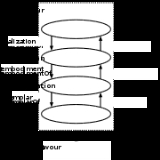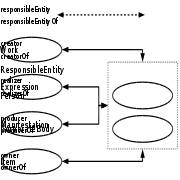
Functional Requirements for Bibliographic Records
Encyclopedia
Functional Requirements for Bibliographic Records—or FRBR, sometimes pronounced ˈfɜrbər—is a conceptual entity-relationship model
developed by the International Federation of Library Associations and Institutions
(IFLA) that relates user tasks of retrieval and access in online library catalogues and bibliographic databases from a user’s perspective. It represents a more holistic approach to retrieval and access as the relationships between the entities provide links to navigate through the hierarchy of relationships. The model is significant because it is separate from specific cataloguing standards such as AACR2
or International Standard Bibliographic Description
(ISBD).

 FRBR comprises groups of entities:
FRBR comprises groups of entities:
Group 1 entities are the foundation of the FRBR model:
Entity-relationship model
In software engineering, an entity-relationship model is an abstract and conceptual representation of data. Entity-relationship modeling is a database modeling method, used to produce a type of conceptual schema or semantic data model of a system, often a relational database, and its requirements...
developed by the International Federation of Library Associations and Institutions
International Federation of Library Associations and Institutions
The International Federation of Library Associations and Institutions is the leading international association of library organisations. It is the global voice of the library and information profession, and its annual conference provides a venue for librarians to learn from one another...
(IFLA) that relates user tasks of retrieval and access in online library catalogues and bibliographic databases from a user’s perspective. It represents a more holistic approach to retrieval and access as the relationships between the entities provide links to navigate through the hierarchy of relationships. The model is significant because it is separate from specific cataloguing standards such as AACR2
AACR2
AACR2 stands for the Anglo-American Cataloguing Rules, Second Edition. It is published jointly by the American Library Association, the Canadian Library Association, and the Chartered Institute of Library and Information Professionals in the UK. The editor is Michael Gorman, a British-born...
or International Standard Bibliographic Description
International Standard Bibliographic Description
The International Standard Bibliographic Description is a set of rules produced by the International Federation of Library Associations and Institutions to describe a wide range of library materials within the context of a catalog. The consolidated edition of the ISBD was published in 2007...
(ISBD).
FRBR Entities


- Group 1 entities are work, expression, manifestation, and item (WEMI). They represent the products of intellectual or artistic endeavour.
- Group 2 entities are person and corporate body, responsible for the custodianship of Group 1’s intellectual or artistic endeavour.
- Group 3 entities are subjects of Group 1 or Group 2’s intellectual endeavour, and include concepts, objects, events, places.
Group 1 entities are the foundation of the FRBR model:
- Work is a "distinct intellectual or artistic creation."
- Expression is "the specific intellectual or artistic form that a work takes each time it is 'realized.'"
- Manifestation is "the physical embodiment of an expression of a work. As an entity, manifestation represents all the physical objects that bear the same characteristics, in respect to both intellectual content and physical form."
- Item is "a single exemplar of a manifestation. The entity defined as item is a concrete entity."
Relationships
FRBR is built upon relationships between and among entities. "Relationships serve as the vehicle for depicting the link between one entity and another, and thus as the means of assisting the user to ‘navigate’ the universe that is represented in a bibliography, catalogue, or bibliographic database." Examples of relationship types include, but are not limited to:Equivalence Relationships
Equivalence relationships exist between exact copies of the same manifestation of a work or between an original item and reproductions of it, so long as the intellectual content and authorship are preserved. Examples include reproductions such as copies, issues, facsimiles and reprints, photocopies, and microfilms.Derivative Relationships
Derivative relationships exist between a bibliographic work and a modification based on the work. Examples include:- Editions, versions, translations, summaries, abstracts, and digests
- Adaptations that become new works but are based on old works
- Genre changes
- New works based on the style or thematic content of the work
Descriptive Relationships
Descriptive relationships exist between a bibliographic entity and a description, criticism, evaluation, or review of that entity, such as between a work and a book review describing it. Descriptive relationships also includes annotated editions, casebooks, commentaries, and critiques of an existing work.External links
- RDA: Resource Description and Access
- The FRBR Blog: A weblog following developments around the world in FRBR
- http://www.ifla.org/files/cataloguing/frbr/frbr_2008.pdf: International Federation of Library Associations and Institutions Functional Requirements for Bibliographic Records

